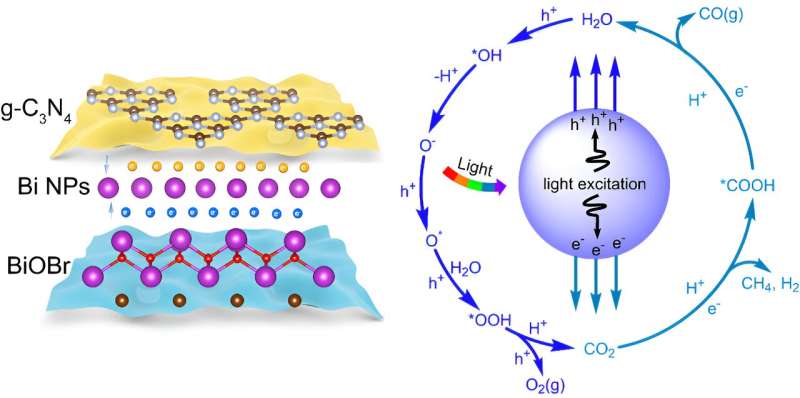This article has been reviewed according to Science X's editorial process and policies. Editors have highlighted the following attributes while ensuring the content's credibility:
fact-checked
trusted source
proofread
Highly efficient carbon dioxide photoreduction guided by machine learning and first-principles calculation

Photocatalytic reduction of CO2 to high-value carbon-based fuels holds tremendous potential in addressing the growing energy crisis. However, the high C=O bond energy of CO2 molecules (750 kJ·mol-1) makes it challenging to activate and reduce CO2.
Therefore, the construction of photocatalysts with novel electron transfer pathways is meaningful. Compared with the traditional single electron transfer channel, the development of multi-electron channels based on layered materials has obvious advantages in the improvement of carrier transport. Nevertheless, the rational design of a desirable photocatalytic model for multi-electron channels with optimized parameters is quite challenging.
Recently, a study titled "Constructing dual electron transfer channels to accelerate CO2 photoreduction guided by machine learning and first-principles calculation" was designed and led by Prof. Jizhou Jiang from Wuhan Institute of Technology, China.
This work combines first-principles calculating and machine learning to successfully predict and prepare a novel BiOBr-Bi-g-C3N4 sandwich structure with dual electron transport channels for photocatalytic CO2 reduction. There are three main reasons for the favorable activity by the novel structure:
(1) the introduced g-C3N4 nanosheets demonstrate a similar energy level structure with BiOBr, which benefits for forming an electronic superposition state;
(2) the excited carriers can be efficient separation and transferred owing to the special double electron transfer channels;
(3) since the photo-generated carrier of BiOBr and g-C3N4 have different time decay behavior, a multi-timescale reaction mechanism for CO2 reduction can be constructed to optimize the reaction pathway.
An enhanced photocatalytic performance of CO2 reduction (43 μmol g-1 h-1) is received by the BiOBr-Bi-g-C3N4 quantum well structure. Five machine learning models were used to explore the linear law of the various influence factors on the efficiency of multi-electron channels. The mechanism of photocatalysis was investigated systematically.
The results were published in Chinese Journal of Catalysis.
More information: Lijing Wang et al, Constructing dual electron transfer channels to accelerate CO2 photoreduction guided by machine learning and first-principles calculation, Chinese Journal of Catalysis (2023). DOI: 10.1016/S1872-2067(23)64546-2
Provided by Chinese Academy of Sciences





















